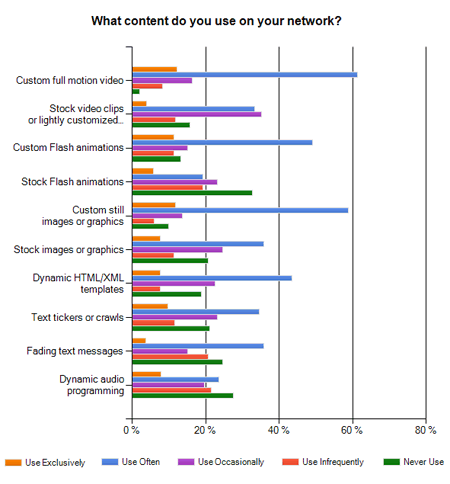What kinds of content do people run on their screens?
To learn more about the content people are running on their screens today, we added a new question to this year's digital signage pricing survey, asking respondents to describe the content mix that runs on their screens. The answers were quite interesting. For starters, most networks don't use one type of content (e.g. full motion video) exclusively, but instead rely on a combination of videos, images and dynamic content to fill up their digital signage playlists. Anecdotally, it's safe to say that most of the screens out there run a lot of video content. But our survey results indicate that while video is near ubiquitous (with over 90% of respondents' screens running it), the mix of other content types is quite broad:

After custom full motion video, custom still images is the next most popular content type. I know this sounds a little counter-intuitive, since most people think digital signs are all about motion. But based on our own research, stills can be extremely effective at communicating a message (and are cheap to create relative to other content types). Custom Flash animations come in a close third.
I was pleased to see that stock content, whether video, Flash or still images, is employed significantly less than potentially more expensive custom stuff. While stock footage can serve as affordable eye-candy, it can't do much to communicate a message unless you pair it with custom elements. Remember folks, our medium is all about the message. I wouldn't expect the usage of stock content to disappear anytime soon, since many networks will continue to need cheap filler. But as the cost of customizing content continues to decline, I suspect we'll see a greater number of people turn to stock content as a starting point for developing more custom material, rather than running it unaltered.
It was also great to see that more people are using fading text messages instead of scrolling tickers and crawls, and 20% of respondents don't use tickers or crawls at all. In the past, we've discussed the scientific evidence illustrating just how terrible tickers are at conveying information. But despite that, many continue to misuse tickers in the field. Hopefully when we poll users again next year, we'll see a continuing trend away from these types of scrolling messages.
What's the future of content?
Dynamic content made a stronger showing than I expected. About half of our respondents said they already use dynamic HTML or XML templates "often" or "exclusively," with another 25% or so indicating that they use them "occasionally" or "infrequently" (but not never). The technical barriers to creating this kind of content are still somewhat high, but they're rapidly shrinking, which will likely lead to a further increase in the use of dynamic templates. Additionally, with the sophisticated new design, layout and multimedia capabilities of HTML5 and CSS3, content designers will finally have an open, standards-compliant way to build and script dynamic content.
Of course, this could complicate our survey questions in the future, since dynamic templates, animations, video files and all sorts of other things will all sort of merge together at some point. However, a lot of people have enough trouble cobbling together good looking JPEG files, so I think we have a few years yet before everyone becomes comfortable with using dynamically updated content, scripts and the like.
Bottom line: while dynamic templates are nothing new, a lot more people use them than I would have guessed, at least from looking at the digital screens that I regularly come across. And as costs decline and capabilities improve and become more accessible, we should expect their use to grow.
It's obviously not possible to infer a huge amount about the digital signage content landscape from a single question answered by a few hundred survey takers. But combined with the research results we've gathered over the years and the opinions of other experts, the conclusions that we can draw are encouraging:
- More people are using custom content to make their digital signs communicate a message, instead of just trying to make the screens look pretty by piping in unmodified stock footage.
- They're favoring content formats like video, still images and Flash animations, which have the potential to be more effective at imparting information than text tickers and fades.
- The majority of folks seem to be using a multitude of different content types to get their messages out.
Which factor stands in the way of getting better content onto the millions of screens out there? Is it cost, lack of expertise, or something else altogether? Leave a comment and let us know!

 Subscribe to the Digital Signage Insider RSS feed
Subscribe to the Digital Signage Insider RSS feed
Comments
RSS feed for comments to this post